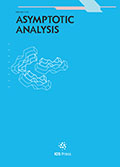Authors: Gustafsson, Björn | Heron, Bernard | Mossino, Jacqueline
Article Type:
Research Article
Abstract:
We consider energy functionals, or Dirichlet forms, J_\varOmega^\varepsilon(u)= \int_\varOmega (A^\varepsilon \nabla u, \nabla u) \,\mathrm{d}x= \sum^N_{i,j=1} \, \int_\varOmega a^\varepsilon_{ij} \, \frac{\curpartial u}{\curpartial x_i} \, \frac{\curpartial u}{\curpartial x_j} \,\mathrm{d}x, for a class \mathcal{G} of bounded domains \varOmega\subset\mathbb{R}^N , with \varepsilon >0 a fine structure parameter and with symmetric conductivity matrices A^\varepsilon=(a^\varepsilon_{ij})\in L_\mathrm{loc}^\infty(\mathbb{R})^{N\times N} which are functions only of the first coordinate x_1 and which are locally uniformly elliptic for each fixed \varepsilon>0 . We show that if the functions (of x_1 ) b^\varepsilon_{11}={1}/{a^\varepsilon_{11}}
…, b^\varepsilon_{1j}={a^\varepsilon_{1j}}/{a^\varepsilon_{11}}\ (j\geq 2) , b^\varepsilon_{ij}= a^\varepsilon_{ij} - {a^\varepsilon_{i1}a^\varepsilon_{1j}}/{a^\varepsilon_{11}} \ (i, j\geq 2) converge weakly* as measures towards corresponding limit measures b_{ij} as \varepsilon\to 0 , if the (1,1) ‐coefficient m_{11}^\varepsilon of (A^\varepsilon)^{-1} is bounded in L_\mathrm{loc}^1(\mathbb{R}) and if none of its weak* cluster measures has atoms in common with b_{ii} , i\geq 2 , then the family J^\varepsilon=\{J_\varOmega^\varepsilon \}_{\varOmega\in \mathcal{G}} \varGamma ‐converges in a local sense towards a naturally defined limit family J=\{J_\varOmega \}_{\varOmega\in \mathcal{G}} as \varepsilon\to 0 . An alternative way of formulating the conclusion is to say that the energy densities (A^\varepsilon\nabla u,\nabla u) \varGamma ‐converge in a distributional sense towards the corresponding limit density. Writing J_\varOmega^\varepsilon in terms of B^\varepsilon=(b_{ij}^\varepsilon) it becomes J_\varOmega^\varepsilon(u) = \int_\varOmega \biggl(\frac{\curpartial u}{\curpartial x_1} + \sum^N_{j=2} b^\varepsilon_{1j} \,\frac{\curpartial u}{\curpartial x_j}\biggr)^2 \frac{1}{b^\varepsilon_{11}}\,\mathrm{d}x+ \sum^N_{i,j=2} \,\int_\varOmega \, \frac{\curpartial u}{\curpartial x_i} \, \frac{\curpartial u}{\curpartial x_j}\, b^\varepsilon_{ij} \,\mathrm{d}x, and the definition of J_\varOmega and the limit density (A\nabla u,\nabla u) is obtained by properly replacing the b^\varepsilon_{ij}\in L_\mathrm{loc}^\infty (\mathbb{R}) by the limit measures b_{ij} and making sense to everything for u in a certain linear subspace of L_\mathrm{loc}^2(\mathbb{R}^N) .
Show more
Citation: Asymptotic Analysis,
vol. 22, no. 3-4, pp. 261-302, 2000
Price: EUR 27.50





